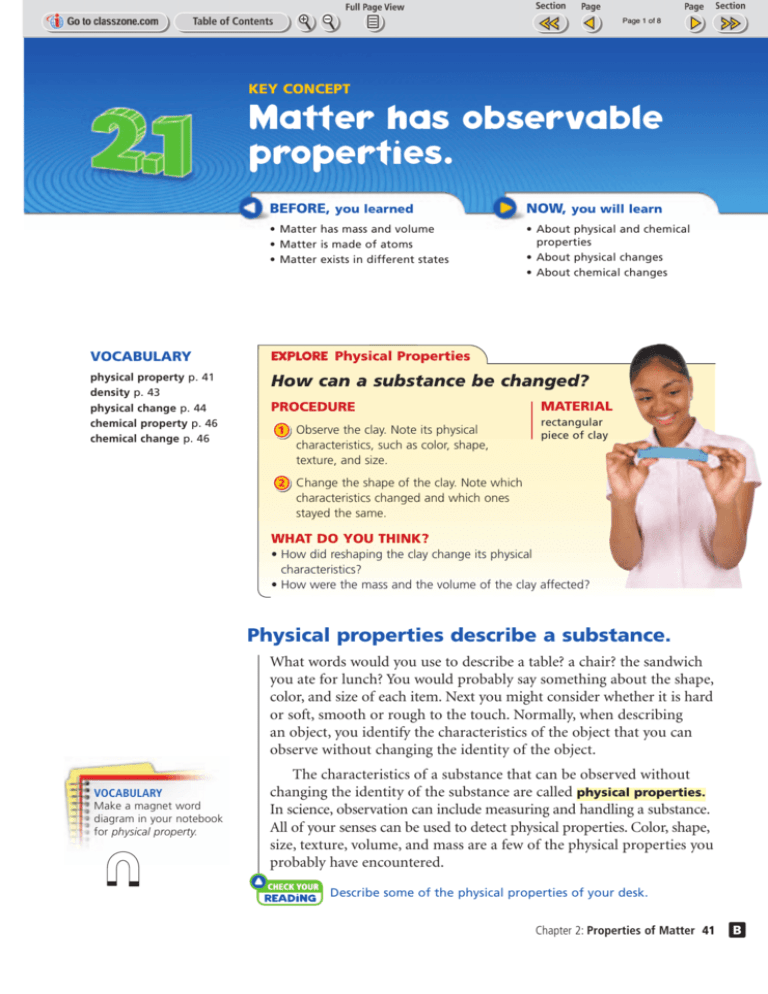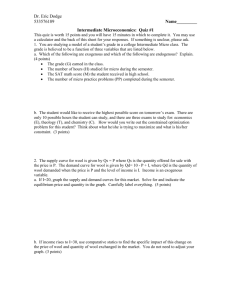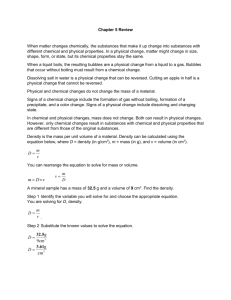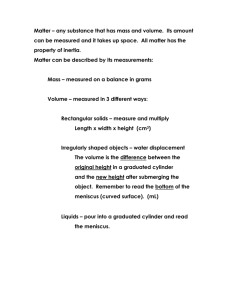Matter has observable properties.
advertisement

Page 1 of 8 KEY CONCEPT Matter has observable properties. BEFORE, you learned NOW, you will learn • Matter has mass and volume • Matter is made of atoms • Matter exists in different states • About physical and chemical properties • About physical changes • About chemical changes VOCABULARY EXPLORE Physical Properties physical property p. 41 density p. 43 physical change p. 44 chemical property p. 46 chemical change p. 46 How can a substance be changed? PROCEDURE 1 Observe the clay. Note its physical characteristics, such as color, shape, texture, and size. MATERIAL rectangular piece of clay 2 Change the shape of the clay. Note which characteristics changed and which ones stayed the same. WHAT DO YOU THINK? • How did reshaping the clay change its physical characteristics? • How were the mass and the volume of the clay affected? Physical properties describe a substance. What words would you use to describe a table? a chair? the sandwich you ate for lunch? You would probably say something about the shape, color, and size of each item. Next you might consider whether it is hard or soft, smooth or rough to the touch. Normally, when describing an object, you identify the characteristics of the object that you can observe without changing the identity of the object. VOCABULARY Make a magnet word diagram in your notebook for physical property. The characteristics of a substance that can be observed without changing the identity of the substance are called physical properties. In science, observation can include measuring and handling a substance. All of your senses can be used to detect physical properties. Color, shape, size, texture, volume, and mass are a few of the physical properties you probably have encountered. Check Your Reading Describe some of the physical properties of your desk. Chapter 2: Properties of Matter 41 A B Page 2 of 8 Physical Properties How do you know which characteristics are physical properties? Just ask yourself whether observing the property involves changing the substance to a different substance. For example, you can stretch a rubber band. Does stretching the rubber band change what it is made of? No. The rubber band is still a rubber band before and after it is stretched. It may look a little different, but it is still a rubber band. reminder Because all formulas for volume involve the multiplication of three measurements, volume has a unit that is cubed (such as cm3). Mass and volume are two physical properties. Measuring these properties does not change the identity of a substance. For example, a lump of clay might have a mass of 200 grams (g) and a volume of 100 cubic centimeters (cm3). If you were to break the clay in half, you would have two 100 g pieces of clay, each with a volume of 50 cm3. You can bend and shape the clay too. Even if you were to mold a realistic model of a car out of the clay, it still would be a piece of clay. Although you have changed some of the properties of the object, such as its shape and volume, you have not changed the fact that the substance you are observing is clay. Check Your Reading Which physical properties listed above are found by taking measurements? Which are not? Physical Properties Physical properties of clay—such as volume, mass, color, texture, and shape—can be observed without changing the fact that the substance is clay. Block of Clay Shaped Clay COMPARE AND CONTRAST Which physical properties do the two pieces of clay have in common? Which are different? A B 42 Unit: Matter and Energy Page 3 of 8 Density The relationship between the mass and the volume of a substance is another important physical property. For any substance, the amount of mass in a unit of volume is constant. For different substances, the amount of mass in a unit of volume may differ. This relationship explains why you can easily lift a shoebox full of feathers but not one filled with pennies, even though both are the same size. A volume of pennies contains more mass than an equal volume of feathers. The relationship between mass and volume is called density. Density is a measure of the amount of matter present in a given volume of a substance. Density is normally expressed in units of grams per cubic centimeter (g/cm3). In other words, density is the mass in grams divided by the volume in cubic centimeters. m m ass Density = !! D = !! V Volume How would you find the density of 200 g of clay with a volume of 100 cm3? You calculate that the clay has a density of 200 g divided by 100 cm3, or 2 g/cm3. If you divide the clay in half and find the density of one piece of clay, it will be 100 g/50 cm3, or 2 g/cm3—the same as the original piece. Notice that density is a property of a substance that remains the same no matter how much of the substance you have. reading tip The density of solids is usually measured in grams per cubic centimeter (g/cm3). The density of liquids is usually measured in grams per milliliter (g/mL). Recall that 1 mL " 1 cm3. Calculating Density Sample Problem A glass marble has a volume of 5 cm3 and a mass of 13 g. What is the density of glass? What do you know? Volume = 5 cm3, mass = 13 g What do you want to find out? Density m Write the formula: D = !V! 13 g Substitute into the formula: D = !! 3 5 cm Calculate and simplify: D = 2.6 g/cm3 Check that your units agree: Unit is g/cm3. Unit of density is g/cm3. Units agree. Answer: D = 2.6 g/cm3 Practice the Math 1. A lead sinker has a mass of 227 g and a volume of 20 cm3. What is the density of lead? 2. A glass of milk has a volume of 100 cm3. If the milk has a mass of 103 g, what is the density of milk? Chapter 2: Properties of Matter 43 A B Page 4 of 8 MAIN IDEA WEB As you read, organize your notes in a web. Physical Changes You have read that a physical property is any property that can be observed without changing the identity of the substance. What then would be a physical change? A physical change is a change in any physical property of a substance, not in the substance itself. Breaking a piece of clay in half is a physical change because it changes only the size and shape of the clay. Stretching a rubber band is a physical change because the size of the rubber band changes. The color of the rubber band sometimes can change as well when it is stretched. However, the material that the rubber band is made of does not change. The rubber band is still rubber. What happens when water changes from a liquid into water vapor or ice? Is this a physical change? Remember to ask yourself what has changed about the material. Ice is a solid and water is a liquid, but both are the same substance—both are composed of H2O molecules. As you will read in more detail in the next section, a change in a substance’s state of matter is a physical change. Check Your Reading How is a physical change related to a substance’s physical properties? A substance can go through many different physical changes and still remain the same substance. Consider, for example, the changes that happen to the wool that ultimately becomes a sweater. 1 Wool is sheared from the sheep. The wool is then cleaned and placed into a machine that separates the wool fibers from one another. Shearing and separating the fibers are physical changes that change the shape, volume, and texture of the wool. 2 The wool fibers are spun into yarn. Again, the shape and volume of the wool change. The fibers are twisted so that they are packed more closely together and are intertwined with one another. 3 The yarn is dyed. The dye changes the color of the wool, but it does not change the wool into another substance. This type of color change is a physical change. 4 Knitting the yarn into a sweater also does not change the wool into another substance. A wool sweater is still wool, even though it no longer resembles the wool on a sheep. It can be difficult to determine if a specific change is a physical change or not. Some changes, such as a change in color, also can occur when new substances are formed during the change. When deciding whether a change is a physical change or not, ask yourself whether you have the same substance you started with. If the substance is the same, then the changes it underwent were all physical changes. A B 44 Unit: Matter and Energy Page 5 of 8 Physical Changes The process of turning wool into a sweater requires that the wool undergo physical changes. Changes in shape, volume, texture, and color occur as raw wool is turned into a colorful sweater. 1 Shearing 2 Preparing the wool produces physical changes. The wool is removed from the sheep and then cleaned before the wool fibers are separated. Spinning Further physical changes occur as machine twists the wool fibers into a long, thin rope of yarn. 3 Dyeing Dyeing produces color changes but does not change the basic substance of the wool. 4 The final product, a wool sweater, is still wool. How does the yarn in the sweater differ from the wool on the sheep? Chapter 2: Properties of Matter 45 A B Page 6 of 8 Chemical properties describe how substances form new substances. RESOURCE CENTER CLASSZONE.COM Learn about the chemical properties of matter. INFER The bust of Abraham Lincoln is made of bronze. Why is the nose a different color from the rest of the head? If you wanted to keep a campfire burning, would you add a piece of wood or a piece of iron? You would add wood, of course, because you know that wood burns but iron does not. Is the ability to burn a physical property of the wood? The ability to burn seems to be quite different from physical properties such as color, density, and shape. More important, after the wood burns, all that is left is a pile of ashes and some new substances in the air. The wood has obviously changed into something else. The ability to burn, therefore, must describe another kind of property that substances have—not a physical property but a chemical property. Chemical Properties and Changes Chemical properties describe how substances can form new substances. Combustibility, for example, describes how well an object can burn. Wood burns well and turns into ashes and other substances. Can you think of a chemical property for the metal iron? Especially when left outdoors in wet weather, iron rusts. The ability to rust is a chemical property of iron. The metal silver does not rust, but eventually a darker substance called tarnish forms on its surface. You may have noticed a layer of tarnish on some silver spoons or jewelry. The chemical properties of copper cause it to become a blue-green color when it is exposed to air. A famous example of tarnished copper is the Statue of Liberty. The chemical properties of bronze are different. Some bronze objects tarnish to a dark brown color, like the bust of Abraham Lincoln in the photograph on the left. Chemical properties can be identified by the changes they produce. The change of one substance into another substance is called a chemical change. A piece of wood burning, an iron fence rusting, and a silver spoon tarnishing are all examples of chemical changes. A chemical change affects the substances involved in the change. During a chemical change, combinations of atoms in the original substances are rearranged to make new substances. For example, when rust forms on iron, the iron atoms combine with oxygen atoms in the air to form a new substance that is made of both iron and oxygen. A chemical change is also involved when an antacid tablet is dropped into a glass of water. As the tablet dissolves, bubbles of gas appear. The water and the substances in the tablet react to form new substances. One of these substances is carbon dioxide gas, which forms the bubbles that you see. A B 46 Unit: Matter and Energy Page 7 of 8 Not all chemical changes are as destructive as burning, rusting, or tarnishing. Chemical changes are also involved in cooking. When you boil an egg, for example, the substances in the raw egg change into new substances as energy is added to the egg. When you eat the egg, further chemical changes take place as your body digests the egg. The process forms new molecules that your body then can use to function. Check Your Reading Give three examples of chemical changes. The only true indication of a chemical change is that a new substance has been formed. Sometimes, however, it is difficult to tell whether new substances have been formed or not. In many cases you have to judge which type of change has occurred only on the basis of your observations of the change and your previous experience. However, some common signs can suggest that a chemical change has occurred. You can use these signs to guide you as you try to classify a change that you are observing. Chemical Changes What are some signs of a chemical change? SKILL FOCUS Measuring PROCEDURE 1 Measure 80 mL of water and pour it into one of the cups. 2 Add 3 full droppers of iodine solution. Record your observations. 3 Add 1 spoonful of cornstarch to the iodine solution and stir. Record your observations. 4 Measure 50 mL of water and pour it into the second cup. 5 Using a clean eyedropper, add 4 full droppers of the iodine/cornstarch solution to the second cup. 6 Drop a vitamin C tablet into the second cup and stir the liquid with a clean spoon until the tablet is dissolved. Record your observations. WHAT DO YOU THINK? • What changes did you observe in the first cup? in the second cup? MATERIALS • graduated cylinder • water • 2 clear plastic cups • 2 eyedroppers • iodine solution • cornstarch • spoon • vitamin C tablet TIME 15 minutes • Do you think that chemical changes occurred? Why or why not? • What are some characteristics of chemical changes? CHALLENGE Describe some chemical changes that you have seen take place in your home or school. 47 A B Page 8 of 8 Carbon dioxide bubbles form as substances in the tablet react with water. Signs of a Chemical Change You may not be able to see that any new substances have formed during a change. Below are some signs that a chemical change may have occurred. If you observe two or more of these signs during a change, you most likely are observing a chemical change. Production of an Odor Some chemical changes produce new smells. The chemical change that occurs when an egg is rotting produces the smell of sulfur. If you go outdoors after a thunderstorm, you may detect an unusual odor in the air. The odor is an indication that lightning has caused a chemical change in the air. Chemical changes often are accompanied by a change in temperature. You may have noticed that the temperature is higher near logs burning in a campfire. Change in Temperature A change in color is often an indication of a chemical change. For example, fruit may change color when it ripens. Change in Color When an antacid tablet makes contact with water, it begins to bubble. The formation of gas bubbles is another indicator that a chemical change may have occurred. Formation of Bubbles When two liquids are combined, a solid called a precipitate can form. The shells of animals such as clams and mussels are precipitates. They are the result of a chemical change involving substances in seawater combining with substances from the creatures. Formation of a Solid Check Your Reading KEY CONCEPTS CRITICAL THINKING 1. What effect does observing a substance’s physical properties have on the substance? 4. Synthesize Why does the density of a substance remain the same for different amounts of the substance? 2. Describe how a physical property such as mass or texture can change without causing a change in the substance. 3. Explain why burning is a chemical change in wood. A B Give three signs of chemical changes. Describe one that you have seen recently. 48 Unit: Matter and Energy 5. Calculate What is the density of a block of wood with a mass of 120 g and a volume of 200 cm3? CHALLENGE 6. Infer Iron can rust when it is exposed to oxygen. What method could be used to prevent iron from rusting?





